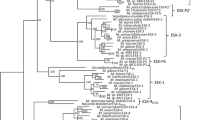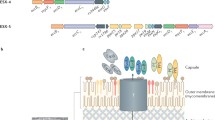Abstract
Over the past 10 years, major advances have been made in the field of molecular mycobacterioiogy. These include the generation of shuttle vectors for use in both Escherichia coli and mycobacteria, electroporation protocols to introduce these plasmids into mycobacteria and promoter cassettes, which can be used to drive the expression of cloned genes in the mycobacterial host (1–6). Similar procedures have been instrumental in the study of many aspects of prokaryotic biology but, in their absence, our understanding of basic processes within species of mycobacteria has been limited. Similarly, the ability to overexpress cloned genes in bacteria has been important in revealing the functions of a great diversity of heterologous proteins. Using Mycobacterium vaccae as the host, the available expression technology has allowed the overexpression, purification and crystallization of the Mycobacterium tuberculosis superoxide dismutase (5,7). The elucidation of the crystal structure of this important enzyme has yielded some very interesting information on protein structure and function in M. tuberculosis. Similarly, the glycosylation of mycobacterial proteins (which cannot be replicated in other bacterial hosts such as E. coli) is being investigated using these expression systems (8,9). In order to benefit from the wealth of information being presented to the screntitic community in the what has been termed the “post-genomic era of microbiology,” the continued utilization and improvement of such methodology is of paramount importance,
Similar content being viewed by others
Referenes
Snapper, S. B., Melton, R. E., Mustafa, S, Kieser, T., and Jacobs, Jr., W R (1990) Isolation and characterization of efficient plasmid transformation mutants of Mycobacterium smegmatis Mol. Microbiol 4, 1911–1919.
Stover, C. K, de la Cruz, V F, Fuerst, T R., Burlem, J E, Benson, L. A., Bennett, L. T., Bansal, G P, Young, J F, Lee, M. H., Hatfull, G F, Snapper, S B., Barletta, R G, Jacobs, W R., and Bloom, B. R. (1991) New use of BCG for recombinant vaccines Nature 351, 4X–539.
Ranes, M G, Rauzier, J., Lagranderie, M., Gheorghiu, M., and Gicquel, B. (1990) Functional analysis of pAL5000, a plasmid from Mycobacterium fortuitum Construction of a “mini” mycobacterium-Escherichia coli shuttle vector. J, Bacterzol 172, 2793–2797
Radford, A. J. and Hodgson, A L. M. (1991) Construction and characterization of a mycobacterium-Escherichia coli shuttle vector. Plasmid 25, 149–153.
Garbe, T. R, Barathi, J., Barnini, S., Zhang, Y., Abou-Zeid, C, Tang, D, Mukherjee, R., and Young, D B. (1994) Transformation of mycobacterial species using hygromycin resistance as selectable marker. Microbiology 140, 133–138
Foley-Thomas, E. M, Whipple, D. L, Bermudez, L E., and Barletta, R. G (1995) Phage infection, transfection and transformation of Mycobacterium avium complex and Mycobacterium paratuberculosis. Microbiology 141, 1173–81.
Cooper, J. B, McIntyre, K., Badasso, M. O., Wood, S. P, Zhang, Y., Garbe, T. R., and Young, D (1995) X-ray structure analysis of the iron-dependent superoxide dismutase from Mycobacterium tuberculosis at 2. 0 Angstroms resolution reveals novel dimer-dimer interactions. J. Mol Biol. 246, 531–44
Garbe, T., Harris, D, Vordermeier, M., Lathrigra, R., Ivanyi, J., and Young, D. (1993) Expression of the Mycobacterium tuberculosis 19-krlodalton antigen in Mycobacterium smegmatis: immunological analysis and evidence of glycosylation. Infect Immun 61, 260–267
Herrmann, J-L, ÓGaora, P., Gallagher, A., Thole, J E R., and Young, D. B (1996) Bacterial glycoproteins a link between glycosylation and proteolytic cleavage of a 19 kDa antigen from Mycobacterium tuberculosis. EMBO 15, 3547–3554.
Chatfield, S. N., Fan-weather, N, Charles, I., Packard, D., Levine, M., Hone, D., Posada, M, Strugnell, R A., and Dougan, G. (1992) Construction of a genetically defined Salmonella typhi Ty2 aroA, aroC mutant for the engineering of a candidate oral typhoid-tetanus vaccine Vaccine 10, 53–60
Langermann, S, Palaszynski, S., Sadziene, A., Stover, C. K., and Koenig, S (1994) Systemic and mucosal immunity induced by a BCG vector expressing outer-surface protein A of Borrelia burgdorferi Nature 372, 552–555
Andrew, P. W. and Roberts, I S (1993) Construction of a bioluminescent Mycobacterium and its use for assay of antimycobacterial agents J Clin Mlcrobiol 31, 2251–2254.
Arain, T. M., Resconi, A. E., Hickey, M. J., and Stover, C. K. (1996) Bioluminescence screening in vitro (Bio-Siv) assays for high-volume antimycobacterial drug drscovery Antimicrob Agents Chemother. 40, 1536–1541.
Hockey, M J., Arain, T M, Shawar, R. M., Humble, D. J., Langhome, M. H., Morgenroth, J N., and Stover, C. K. (1996) Antimicrob. Agents Chemother 40, 400–407.
Zhang, Y., Heym, B., Allen, B., Young, D., and Cole, S. (1992) The catalaseperoxidase gene and isoniazid resistance of Mycobacterium tuberculosis Nature 358, 591–593.
Banerjee, A., Dubnau, E, Quemard, A., Balasubramanian, V., Urn, K. S., Wilson, T, Collins, D., de Lisle, G., and Jacobs, Jr., W R. (1994) inhA, a gene encoding a target for isoniazid and ethionamide in Mycobacterium tuberculosis Science 263, 227–230.
Dhandayuthapani, S., Via, L. E., Thomas, C. A., Horwitz, P M., and Deretic, V (1995) Green fluorescent protein as a marker for gene expression and cell biology of mycobacterial interactions with macrophages. Mol. Microbiol. 17, 901–912.
Kremer, L., Baulard, A., Estaquier, J, Poulain-Godefroy, O,and Locht, C (1995) Green fluorescent protein as a new expression marker in mycobacteria. Mol Microbiol. 17, 913–922.
Dellagostin, O. A., Esposito, G., Eales, L J., Dale, J. W., and McFadden, J (1995) Activity of mycobacterial promoters during intracellular and extracellular growth Microbiology 141, 1785–92.
Curcic, R., Dhandayuthapani, S, and Deretic, V. (1994) Gene expression in mycobacteria: transcriptional fusions based on xylE and analysis of the promoter region of the response regulator mtrA from Mycobacterium tuberculosis. Mol. Microbial 13, 1057–1064.
ÓGaora, P, Barnini, S, Hayward, C, Filley, E., Rook, G., Young, D., and Thole, J (1997) Mycobacteria as immunogens. development of expression vectors for use in multiple mycobacterial species. Med. Principles Prac. 6, 91–96.
Aldovim, A., Husson, R. N., and Young, R A (1993) The uraA locus and homologous recombination in Mycobacterium bovis BCG J Bacteriol 175, 519–524.
Wards, B J and Collins, D. M. (1996) Electroporation at elevated temperatures substantially improves transformation efficiency of slow-growing mycobacteria. FEMS Microbiol Lett 145, 101–106.
Author information
Authors and Affiliations
Editor information
Editors and Affiliations
Rights and permissions
Copyright information
© 1998 Humana Press Inc., Totowa, NJ
About this protocol
Cite this protocol
Gaora, P.Ó. (1998). Expression of Genes in Mycobacteria. In: Parish, T., Stoker, N.G. (eds) Mycobacteria Protocols. Methods in Molecular Biology™, vol 101. Humana Press. https://doi.org/10.1385/0-89603-471-2:261
Download citation
DOI: https://doi.org/10.1385/0-89603-471-2:261
Publisher Name: Humana Press
Print ISBN: 978-0-89603-471-6
Online ISBN: 978-1-59259-576-1
eBook Packages: Springer Protocols




